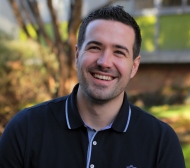News
3D printing bone tissue
Jun 28 2022
Dr Joan Marc Cabot Canyelles, an early career researcher from our University of Tasmania node, has been busy, recently travelling to Dublin City University to work with ACES partner investigator Professor Dermot Diamond to progress research on self-propelled ionic liquid droplets that may be useful in sensing systems.

Following his return to Australia, Joan Marc is now busy packing to travel back to the other side of the world, as he will be moving on from ACES after nearly three years with the Centre.
We caught up with him to hear about his recent travels and his plans for the future.
What is the main focus of your research at ACES?
I’m an Analytical Chemist, working with a team to research the development of new microfluidic scaffolds for the next generation of chemical, bio-sensing and diagnostic devices. We’ve been looking at the manipulation of biomolecules under an electric field, namely electrofluidics. Targeted biomolecules from complex biological fluids can be separated using electric fields and provide an immediate response to diagnostics. We have developed diagnostic platforms for applications in bioactive molecule delivery into soft tissue models, the determination of bacteria and metabolites in urine and bacterial DNA in whole blood, and protein separation.
You recently had the chance to travel as part of your research. Where did you go?
I visited the National Centre for Sensors Research (NCSR) in Dublin City University (DCU) in Ireland. This centre is equipped with advanced facilities and instrumentation to support cutting edge sensor research. The research centre was established in 1999 and is world-class in terms of photo-controllable sensors and actuators.
I was hosted by Professor Dermot Diamond, who has been researching the fundamental science of stimuli responsive polymers, and the development of futuristic autonomous chemical sensing platforms.
How long were you at the NCSR for?
I spent one month in Dublin in June. Coming from the Tasmanian winter I was expecting a perfect ‘hot-ish’ and sunny summer. I was wrong. It was raining the first couple of weeks and the temperature dropped lower than 10 degrees for a few days. I almost bought a jacket, but luckily the weather changed and we managed to enjoy the outdoors for a few days.
What was the reason for visiting NCSR?
I was interested in learning more about the potential of the design and creation of artificial complex cellular and bacterial vesicles used to transport chemical and bioactive components.
We know our body creates chemical stimuli, however when we hurt ourselves, ions present in the epidermis travel to the dermis causing a gradient of electric field between the healthy skin and the wound. This electric field actually helps the cells to move to the wound, bringing the chemicals and necessary reactions to repair the tissue.
This gave us an idea – can we use electric fields to move droplets, like our body does?
On my trip, I studied the possibilities of this concept with the research group at DCU, which has recently developed ionic droplets with special capabilities. The droplets are self-propelled under the effect of a chemical stimulus – in this case, a gradient of chloride.
I believe you’ll be leaving ACES soon. Where are you heading to next?
I am going back to Catalonia, specifically Terrassa. I’ll be working in a multi-disciplinary technology centre that is involved in more than 215 different projects and collaborating with more than 45 countries.
This Centre has several areas of investigation and development, including materials, chemistry, biotechnology, and energy and environment, and recently opened a large research hub in 3D printing. I will be leading a new research group within the department of Smart Systems developing biosensors and diagnostic systems for health and industry applications.
I have conducted four years of research in Australia and more than three of these with ACES. The training in research and innovation abilities that I have learnt across this time has been eye-opening and so rewarding. Now it is time to employ all this knowledge and bring some new advances to the Catalonian community.
I am very lucky to have the opportunity to work on something I love in my home country with my family and friends – it is truly wonderful.
What has been your biggest achievement during your time with ACES?
My biggest achievement has been the electrofluidic control of bioactive molecule delivery into soft tissue models. We used surgical sutures to transport bioactive molecules, including drugs and proteins, by imposition of an electric field with a view to apply in the wound healing area. Using absorbable surgical sutures, we controlled delivery of an anti-inflammatory drug.
We were amazed because this discovery provides a potential alternative approach to the current medical technologies in targeted drug delivery, which is especially useful for cancer treatment or implantable parts. Targeted drug delivery is a significant challenge and important objective for both the pharmaceutical and medical sectors.
What will you miss the most?
I will miss the friends I have made here at the University of Tasmania and across ACES. This is like a little family, and you share all the good and hard moments during your work activities. I would have also liked to have continued some of the projects that are still not finished, but I am very excited to see how they progress. I will definitely miss working here.
So long, farewell and good luck, Joan Marc. We look forward to future collaborations with you.













